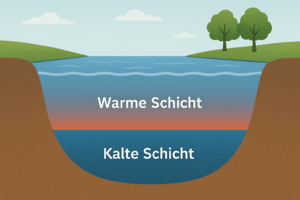Thermal seawater utilization
What is thermal seawater utilization?
Thermal lake water utilization refers to the generation of heating and cooling energy from the thermal energy stored in the water. With the help of heat exchangers and – as a rule – heat pump systems, this energy is used to supply buildings, neighborhoods or industrial plants. It is a regenerative, emission-free and extremely efficient source of energy that can be used in both summer and winter.
Functionality
Seawater has different temperatures at different depths. These natural temperature stratifications can be used in a targeted manner:
- In winter operation, warmer water is extracted from medium depths and fed into the heating circuit via plate heat exchangers, for example.
- In summer operation, water is drawn from deeper, cooler water layers for cooling buildings or processes.
After thermal utilization, the water is returned at a different depth, adjusted for temperature, in order to disturb the natural temperature profile of the lake as little as possible. The extraction and return pipes are hydraulically adjusted so that the impact on the ecosystem is kept to a minimum.
Possible applications
- Residential and commercial districts near bodies of water
- Data centers and industrial facilities with high cooling or heating requirements
- Hospitals, schools or administrative buildings with continuous energy requirements
- Climate-neutral new development areas and campus solutions
Advantages and properties
Regenerative approach: The energy comes from a natural, locally available source – without the direct use of fossil fuels.
Can be used all year round: Can be used in both summer and winter – depending on the temperature profile of the water.
Energy efficiency: Existing temperature differences in the lake can be used efficiently under suitable conditions.
Space-saving: As a rule, no additional roof or open spaces are required, as the water serves as an energy store.
Combinability: The technology can be combined with other systems such as heat pumps, solar thermal energy or storage systems.
Special technical features
- Use of two operating zones (summer/winter) with alternating extraction depth optimizes the energy yield
- Circulation systems with separate inlet and outlet lines maintain the ecological conditions in the watercourse
- High-performance heat exchangers with low spread enable energy-efficient transfer to secondary systems
- Extraction and return points are selected in such a way that temperature stratification is maintained in the water body
Ecological compatibility
The use of thermal seawater is considered to be particularly environmentally friendly if:
- withdrawal quantities and return temperatures are precisely regulated
- the temperature difference (spread) remains minimal
- the return is made at an appropriate depth
- Accompanying limnological studies that take into account the effects on the ecosystem
Interesting links on this topic:
Articles on heat exchangers
Thermal layers in lakes
Further information:
Thermal lake water utilization is also known as lake water thermal energy.


